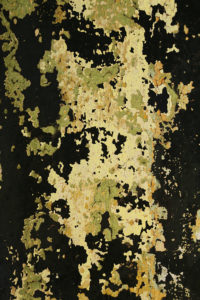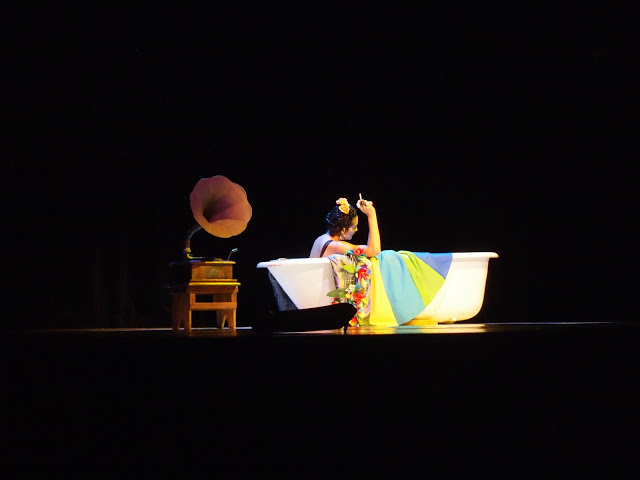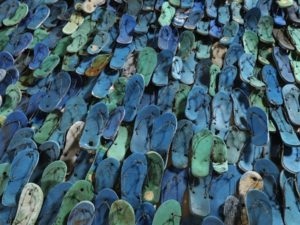
In November last year Sasha Dees started travelling in the Caribbean region, researching the sustainability of contemporary art practices and the influence of international (exchange) projects, funding, markets and politics. During her research she will be keeping a travelogue for Africanah. Her first stop in the region was Ayiti (Haiti), one of the islands in the region she has not spent any time before (see February edition). In March she reported about her stay on Korsou (Curacao). This month the focus is on Aruba.
Tony Capellán, Mar Caribe, 1996.
Caribbean Travelogue
Aruba
Aruba is immediately associated with beautiful white beaches and waving palm trees– a perfect, idealized Paradise. Friends who heard I was going there next couldn’t wait to hear about it. Those who had been before couldn’t wait to tell me all about it. Like Thalma, age 92, who visited the island in the sixties. Her face lights up with the memory of strolling down gorgeous dream-like, long white beaches, sitting in the shadow of a Watapana tree contemplating, or wading in the shallow water early morning or late afternoon which was perfectly safe even for someone like her who couldn’t swim.
But my visit takes place in February, over half a century later, and the vast long stretches of white sand I see on Thalma’s pictures from the sixties are no longer empty. The one hotel that opened its doors right on the beach in 1959 has expanded into a long strip of hotel chains providing over 10,000 beds and about the same amount of imported palm trees, stretchers and parasols occupy the sand. Tourism has totally taken over the Northern part of Aruba, something that has not only benefitted the owners of said hotels but also served a lot of islanders well. Aruba, the Happy Island is one of the richer islands because of its tourism and low unemployment rate. Countries with tourism as their main income never lack promotion and investment in their craft and gift industry or in folklore–and Aruba is no exception. Within my research I was keen to find out if and how contemporary art is benefiting from the resources and disposable income coming from tourism and how does this serve the local population as well as the 1.2 million visitors each year. Do contemporary artists sell more works here? Are there contemporary art galleries? Is there more governmental support? What types of museums exist? What is offered to the local population and the visitors in terms of art and are they interested?
Talking with different players in the field I soon find there is no contemporary art gallery and hasn’t been for a while. There used to be a good gallery years ago for about a decade. When the owner’s partner was appointed a governmental position in DC, the gallery closed and nobody has jumped into the gap.
Alydia Wever, Muhe Frida, from 2011 on, performance
In 2011/2012 artist Alida Martinez organized the first Aruba Biennale, in part as an attraction for foreign visitors, curated by Havana Biennale curator Jose Manuel Noceda. The former Dutch islands are often overlooked by curators and the biennale put the artists from Aruba in context with international artists and brought them to the attention of curators and critics. The catalogue is still available online with LM Publishers. Martinez has tried to get the next edition off the ground ever since. She has secured some funding and in-kind sponsorship but not enough to realize a next edition. The location where the first biennale took place, an old factory building at the old harbor, has been demolished, leaving the organizers with the matter of finding the locations to present work. I soon find out that space is as much of a problem in Aruba as on many other islands.
Ateliers ’89 Academia di Bellas Artes Aruba Foundation, (https://www.ateliers89.com/) which began in 2006, has space in their yards which offers a possibility for presentation of video and films. They also run an exhibition space, which given its bylaws is first and foremost meant for use by its students, alumni, teachers and residents, but it could be used by other artists or curators during select times. It did collaborate with the first Aruba Biennale but given its high use within the scope of Ateliers’89 the reality is that it is hardly ever empty. Casa di Cultura is a commercial space that doesn’t collaborate but rents out a space that could be used for exhibiting for US$500 a day. UNOCA (the national arts fund of Aruba) has a small exhibition space that is used to show works from their collection (people who get funded donate a work in return) and it is available free of charge to artists to present works (a 30% commission is asked on works that are being sold in the space). The space has not been utilized for either of those options lately. Due to the lack of spaces to exhibit, artists like Alida Martinez, Belinda de Veer, Ciro Abath and Osaira Muyale open their studios/homes to the public and sell works out of the studio. Martinez and Muyale used to open up their space for other artists but haven’t done that in the last few years.
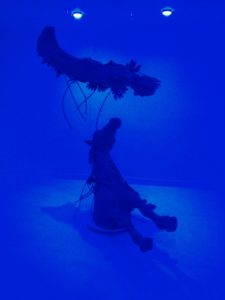
Installation in studio Osaira Muyale, 2014.
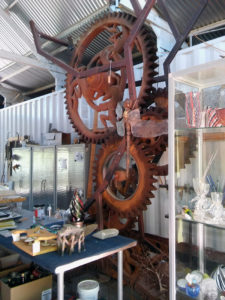
Studio Ciro Abath.
There is no “art tour” promoted by the tourist office and/or hotels to make the tourists aware that studios of contemporary artist are available to visit. Abath, is one individual exception as his wife gives workshops for tourists that are being promoted in the hotels. None of the artists can live off the sales of their works and have other sources of income. No research has been done by the government to see if promoting Contemporary Art to the tourists would improve the income of individual artists. The government does offer individual funding for art projects and travel of artists to exhibitions through UNECO. Visual artists in Aruba (and the other countries that are part of the Dutch Kingdom) qualify to apply for funding for projects, travel, residencies as well as individual support from the Mondrian Fund (the national art fund in the Netherlands).
The available museums I quickly find out are all historical and focused on heritage, something I have found on other islands as well. There is the National Archaeological Museum Aruba (NAMA) with a collection that covers the time from 2500 BCE to the 19th century. Part of the objects are on loan from Leiden (the Netherlands). Many of the objects in past colonial times were shipped from the island to the Netherlands and were “repatriated” a decade ago. The museum was renovated and added a new exhibition hall to the existing space to show these objects and others with a reported 20 million euro European Development Fund grant. The renovation was finished in 2007 and the museum reopened to the public with a newly designed permanent exhibition in July 2009. I did not have a chance to see the museum and its collection as the museum has been closed to the public for over a year because of problems with the air conditioning (climate control).
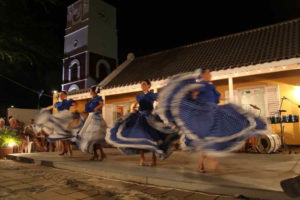
Bon Bini Festival at Fort Zoutman
Fundacion Museo Arubano (FMA) was installed in 1993 for the preservation and promotion of Aruba’s natural and cultural heritage and intends to presents that heritage in 5 museums. The exhibitions in Fort Zoutman (the Historical Museum) in Oranjestad cover the early twentieth century history. I was invited to the weekly (every Tuesday) Bon Bini festival that features folklore dance, music and song and includes an audience participation element and they love it! The contradiction of celebrating colonial times performed by present day local people in primary-colored Spanish dresses dancing a Waltz… not really my thing.
Addressing issues of whiteness, the European gaze, privilege and supremacy in the past decade has put the society at large in a place where such topics can no longer be avoided. The public is demanding space to talk about and present heritage in different ways. Everywhere really and certainly also here in the Caribbean region! This Bon Bini festival just makes me wonder about available space to tell new and current stories as well as existing stories from other perspectives. Also how could contemporary artists play a role in this?
Case in point, just this past week, both printed, broadcasted and social media in Europe, America and the Caribbean region reported extensively about Queen Mary, the collaborative public work by contemporary artists Jeanette Ehlers (Denmark) and LaVaughn Belle (St. Croix). The work was commissioned because of the 100 year anniversary of Denmark selling the now US Virgin Islands (which includesinclude St. Croix) to the United States of America. The sculpture which alludes to the famous photograph of Huey P. Newton is installed as a public work in Copenhagen, Denmark. The work aims to do exactly this—presenting another perspective on the shared history of St. Croix and Denmark.
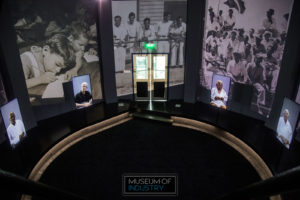
Flow of History, Multimedia installation, 2017, Museum of Industry
Ending on a positive note, FMA’s recently (2015) appointed curator Renwick Heronimo is shaking things up a little. He oversaw the realization of the Museum of Industry (museum 2) which is definitely worth the travel to San Nicolas. Housed in a gorgeous renovated Art Deco water tower dating from 1939, the exhibition design and use of modern technology, is something I hadn’t seen before on the islands while visiting museums. It shows imagery from the wider population and its upstairs (in the tower part) multimedia installation includes stories from elder people coming from different classes in the society: owners of industry vs. employees vs. union vs. government and placed in their context. Where did they migrate from to Aruba, and what was their environment living in Aruba? By talking about their experience and views on their lives and the society at large, the changes that took place and how this influenced these different segments of the society, they shed insight on the history and heritage of Aruba within its industrial sector.
Heronimo also started commissioning contemporary artists to make new work that talks about heritage to be placed into the museums and in doing so bridging heritage to present times and new audiences. His current project, the Community Museum (museum 3) is being installed in the just (2018) restored San Nicolas Store. When Heronimo shows me around he points out the different projects that are being installed here or will be later this year. Local contemporary artists Alyda Wever, Cado de Lannoy, Gilbert Senchi, Glenda Heyliger, Hugo Palmar, King Lie Kwie, Osayra Muyale and Velvet Zoe Ramos all have been commissioned to present contemporary projects that deal with community. Replacing the often stuffy, boring conservative ways of presenting heritage here we can see stories that are authentic to the island and its heritage but talked about and presented in a very refreshing current way from the perspective of local contemporary artists. Already the space is attracting new and younger audiences by having included a small cafe/eatery, Mundi Health Café, and collaborating with existing organizations like Atelier’89 and Maria Silva’s Basha programming recurring evenings of poetry, artist and community talks, and live music.
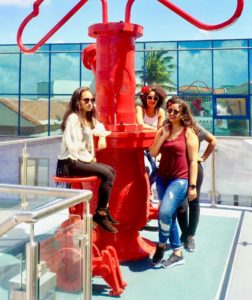
Gilbert Senchi, Bao Palo, 2018, Oil paint on transmuted sand, 3.80 x 3.50 x 2 m, collection: Community Museum Aruba
The other two heritage museums are still in a conceptual phase and have yet to be developed. After the Community Museum, Heronimo will work on developing the Museum of Carnival. A layered approach to dissect Carnival not exclusively from Aruba but also the region at large. Carnival most certainly lends itself to be told by regional contemporary artists like Ebony G .Patterson (Jamaica/USA), Hew Locke (Guyana/UK), Marlon Griffith (Trinidad/Japan) and Sharelly Emanuelson (Aruba/Curacao) to name a few that all are known to have made works around that heritage that would attract visitors from all over the world!
